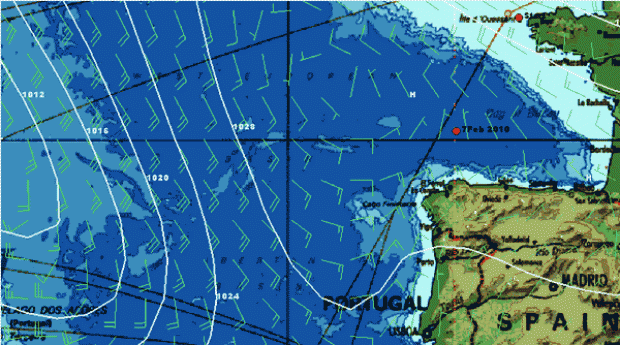From strong into light
Saturday February 7th 2004, Author: James Boyd, Location: Transoceanic
Position at 20h10 45deg 14.170N 08deg 00.270W
Heading: 252 (true)
Speed: 8.1
TWS/D: 8 knots 359deg
16 hours from their flying start off Ouessant, Cheyenne and her crew are continuing to make good progress towards Cape Finisterre (NW corner of Spain), but have begun slowing as they encounter the predicted lighter winds in the southern part of the Bay of Biscay.
The next hours will be important as they must traverse this high pressure ridge before heading further southwest through Sunday - to catch a low pressure system and a quicker ride to the equator. When the 'Code Green' start decision was taken (only 72 hrs ago) it was understood that this first week was going to be challenging.
Meteorologist Ken Cambell, Director of Commanders Weather, noted: "The first hurdle was to get to the start line by this morning. The next one will be to get through this high. The third hurdle will be to get west and south to catch the front.
"The next 9 - 10 hours will be slow - I have spoken to Adrienne [Cahalan] and Steve [Fossett] at about 1800z and so far we are getting exactly what we expected."
From on board Brian Thompson writes....
It was a memorable start to our round the world voyage, some of the most difficult sailing we have ever had on Cheyenne was in the trip to the start line. We left Plymouth at sunset beating into the wind to Ushant. As the night progressed the wind built to 50 knots and then to 60 knots and we reefed down to only a triple reefed main, and tried to maintain the slowest speed possible, about 5 knots , just to stop the boat from leaping off the short steep seas. The tide was flowing in the opposite direction to the wind so that made the sea state particularly bad. The spume from the waves was blowing in spectacular white streaks in the moonlight.
This lasted for about five hours and then conditions improved to a mere 35 knots and we were able to start making progress to the line from our position in mid English Channel.
We saw the island of Ushant quite clearly in the bright moonlight and got to within about five miles before the timekeeper standing on one of the two main lighthouses could see us. He took bearings on us as we approached and at 05.10 he called us as having crossed the line. At the time we had two reefs and the storm jib and were making 18-20 knots with the wind on the beam. The seas were still big from the SW so we had to keep the speed below 20 knots to protect the boat from the waves.
There was no great emotion at the start. We had had a rough night and it was taking all our concentration to keep the boat safe. We just had a good look at the island slipping past us to leeward - that's where we have to come back to after 60+ days.

We knew conditions were going to moderate through the day so we have slowly been pulling up more sail. Now it is sunset on the first day and we have the full main and big gennaker up in a light breeze. The ridge of high pressure we were expecting has slipped over us from the south giving us light winds from astern. As the night passes we can expect the wind to shift more into the north and tomorrow we will be on the other gybe sailing in a southerly wind. This first three days of our trip are going to be very tricky -
there was the big wind at the start which we have overcome, next is the ridge of light air tonight, and tomorrow we have to shoot out to the west to skirt around a low pressure that is heading from the Azores to the Canaries.
Once we have gone past these obstacles we will be in good running conditions to the equator, and we should be able to get back most of the time we will lose at the beginning.
We are not sure if Geronimo have left or not - we should know for sure tomorrow. (They haven't and aren't yet - Ed)
All is good on board, we are starting to eat today, as it was too rough for the first 18 hours after leaving Plymouth. Justin Slattery the new crewman was amazed at how much these big cats twist and move in the rough seas, I suppose the rest of us are used to it, but the motion in the upwind conditions is incredible as the hulls lurch fore and aft as the waves pass by.









Latest Comments
Add a comment - Members log in